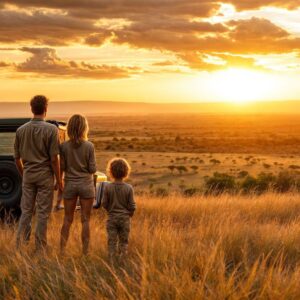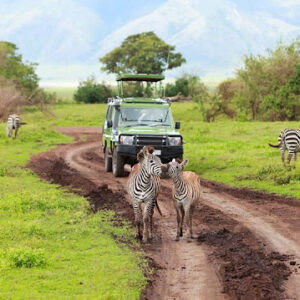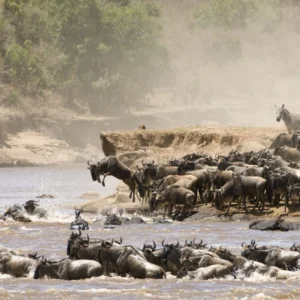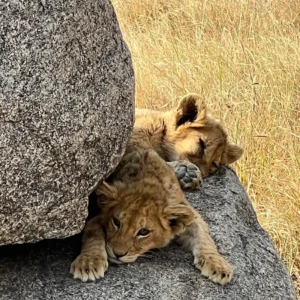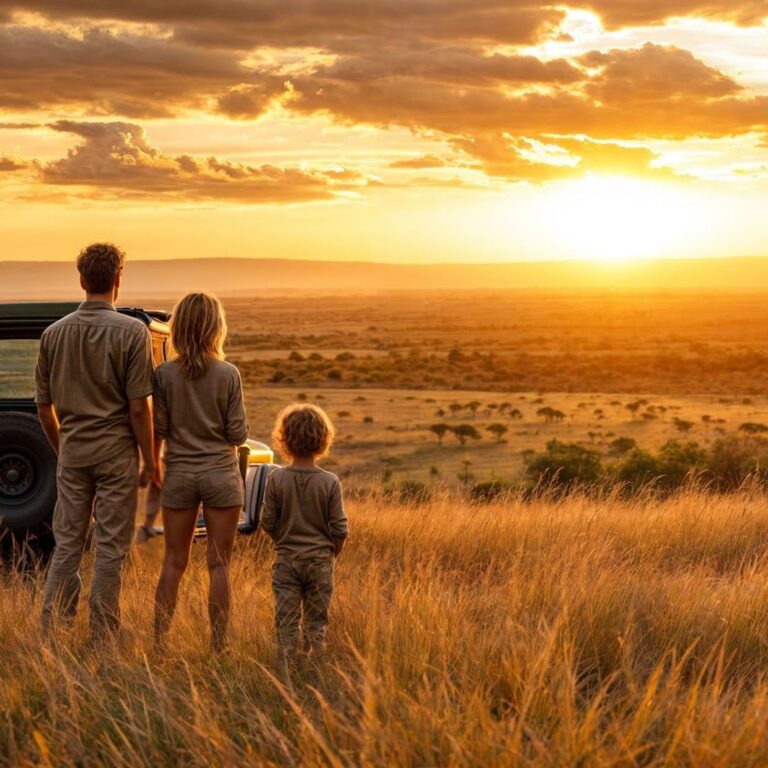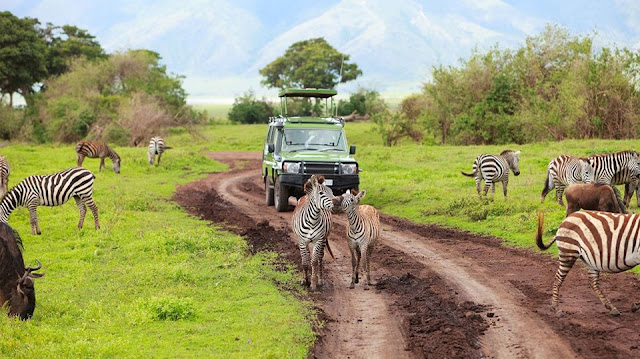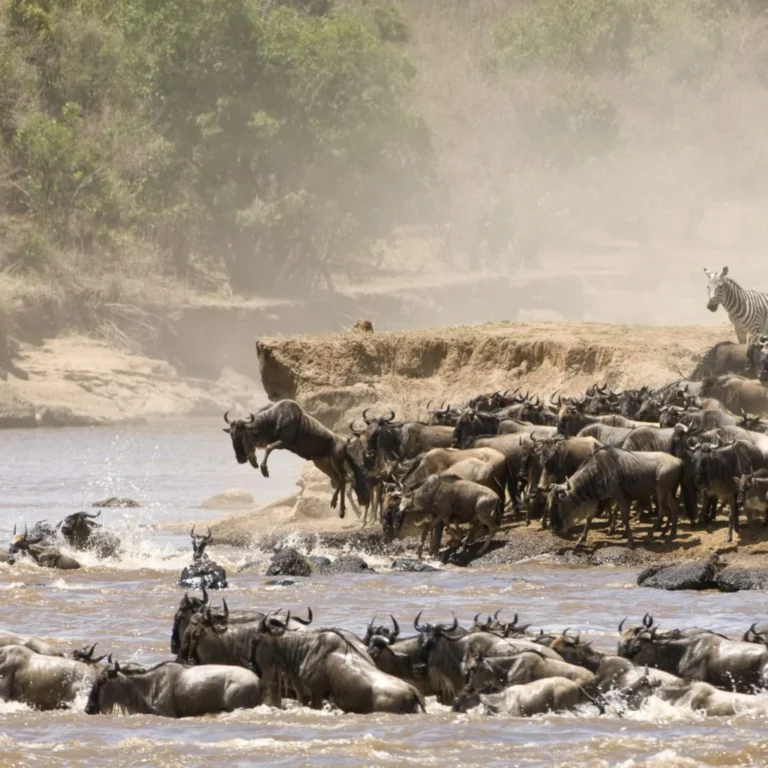A wildebeest migration safari requires careful timing to align with the herd’s movements, focusing on the calving season in the southern Serengeti (January-March) or the river crossings in the Serengeti/Maasai Mara (July-October). Book accommodations, especially luxury mobile camps that follow the herds, well in advance. The annual migration involves a 1200km circuit, but the exact route and timing vary yearly based on rainfall, so consult with tour operators to identify the best location for your chosen safari stage.
The Ultimate Guide to a Wildebeest Migration Safari: Your Front-Row Seat to Nature’s Grandest Show. Imagine the earth trembling beneath millions of hooves, the air thick with dust and the primal cries of the wild. This is the Great Wildebeest Migration, an unparalleled natural spectacle that unfolds across the vast plains of Tanzania’s Serengeti National Park and Kenya’s Maasai Mara. It’s an epic, year-round journey of survival, a testament to the raw power of instinct, and an experience that etches itself into the memory of every fortunate witness. If seeing this living legend is on your bucket list, this comprehensive guide will help you plan your perfect Wildebeest Migration safari.
What is the Great Wildebeest Migration?
At its heart, the Great Migration is the annual movement of over 1.5 million wildebeest, accompanied by hundreds of thousands of zebras and gazelles, in search of fresh grazing and water. It’s a cyclical, nomadic existence driven by the unpredictable patterns of rainfall across the Serengeti ecosystem. While the wildebeest are the undisputed stars. Their journey attracts a full cast of supporting characters: lions, leopards, cheetahs, and hyenas, ever-present to prey on the vulnerable, particularly the young and the weak. This constant pursuit of sustenance creates a dynamic and ever-changing wildlife drama, from mass calving events to perilous river crossings. It’s an ecological ballet on a scale unmatched anywhere else on Earth. Book this: 8 Days | The Great Migration Highlights – Luxury Safari
Why See the Migration in Tanzania?
While the migration briefly spills into Kenya’s Maasai Mara, the vast majority of its annual cycle – roughly 80% – occurs within the boundaries of Tanzania’s Serengeti National Park and the contiguous Ngorongoro Conservation Area. This means that for most of the year, Tanzania offers the prime viewing opportunities, from the dramatic births in the south to the intense river crossings in the north. The sheer scale and diversity of the Serengeti ecosystem provide a stunning backdrop for this epic journey. Ensuring that even when the migration is far, the resident wildlife viewing remains spectacular. Check this: Guide to Great Serengeti Wildebeest Migration
Understanding the Migration Cycle: A Month-by-Month Breakdown
The Tanzania Great Migration is a year-round, circular movement of millions of wildebeest and other animals, driven by the search for fresh grazing land and water, following the seasonal rains. It typically starts with calving in the Southern Serengeti in January/February, moves north through the Central and Western Serengeti for rutting and river crossings (June to July), reaches its peak at the Mara River in the Northern Serengeti (August to October), and then returns south to Tanzania’s short-grass plains.
This natural phenomenon is highly dependent on rainfall and local conditions, making the timing and location of the herds variable. However, staying in certain regions, such as the Central or Northern Serengeti, at different times can increase your chances of witnessing different stages. The key to a successful migration safari lies in understanding its fluid nature. There’s no single “best” month, as each phase offers unique highlights. Your travel dates will dictate where in the Serengeti you should focus your attention and where your chosen camp or lodge should be located.
December – March: The Calving Season & Southern Plains (Ndutu Area)
Location: Southern Serengeti National Park and the Ndutu Conservation Area (just outside the main Serengeti park boundary). What to Expect: This is perhaps the most heartwarming, yet often most intense, phase complete guide to rhe great nigration in Africa. Millions of wildebeest, zebras, and gazelles gather on the short-grass plains, drawn by the nutrient-rich new grasses that emerge after the short rains. February is the peak calving month, with up to 8,000 calves born daily – a truly incredible sight! This abundance of vulnerable newborns naturally attracts a high concentration of predators, leading to thrilling hunting spectacles. The landscape is lush and green, offering fantastic photographic opportunities.
Best for: Witnessing births, intense predator-prey interactions, and expansive herds against a verdant backdrop.
April – May: The Long Rains & Western Corridor Movement
Location: Herds begin to move north-west, entering the Serengeti’s Western Corridor. What to Expect: These are typically the months of the long rains guide to Wildebeest Migration Safari. Making the landscape incredibly green and beautiful, but also potentially challenging for game drives due to muddy roads. The herds are on the move, forming long columns as they head towards the Grumeti River, complete guide to wildebeest migration safari. This can be a quieter period for tourists, offering a more exclusive experience, though sightings might be more dispersed. Mating season often begins around May. Best for: Experiencing the “green season” Serengeti, seeing vast columns on the move, and possibly witnessing early Grumeti River crossings if conditions are right.
June – July: The Grumeti River Crossings & Movement North
Location: Western Corridor of the Serengeti, around the Grumeti River, then pushing further north. What to Expect: As the dry season takes hold, the herds consolidate and continue their northward journey. June often brings the first major river crossings at the Grumeti River. While not as large or dramatic as the Mara River crossings, these can still be exciting, with crocodiles lying in wait. By July, large numbers of wildebeest are moving into the Northern Serengeti, anticipating the ultimate challenge of the Mara River. Best for: Witnessing Grumeti River crossings, seeing massive herds congregating, and enjoying the cooler, drier weather of the early dry season.
August – October: The Mara River Crossings & Northern Serengeti
Location: Northern Serengeti (Kogatende, Lamai Wedge areas), spilling into and out of Kenya’s Maasai Mara. What to Expect: This is arguably the most famous and sought-after period. The herds face the treacherous Mara River, known for its strong currents and resident crocodile population. The crossings chaotic, dramatic, and unpredictable, often happening daily, sometimes multiple times a day, but never guaranteed. The sheer volume of animals trying to cross at various points makes for incredible viewing. This peak safari season, so expect more vehicles around popular crossing points. Best for: The iconic Mara River crossings, high predator action, and vast herds in the dramatic northern landscapes.
November: The Short Rains & Return South
Location: Herds begin to move south from the Northern Serengeti, often dispersing across the central and eastern plains. What to Expect: The short rains begin, revitalizing the southern plains. The migration begins its journey back to the calving grounds. This a transition period, with animals spread out, making them harder to pinpoint in massive groups, but offering excellent general game viewing as predators remain active. Best for: Seeing the migration in a less crowded phase, enjoying lush post-rain landscapes, and potentially witnessing predators stalking.
Choosing Your Safari Type: Accommodation & Logistics
Your choice of accommodation is critical to a successful migration safari, as it dictates your proximity to the herds.
Mobile Tented Camps:
The Ultimate Migration Experience: These camps are designed to move seasonally, setting up close to where the migration is predicted to be. They offer the most immersive and authentic “following the herds” experience.
Style: Ranging from comfortable to ultra-luxury, these camps feature spacious canvas tents with proper beds, en-suite bathrooms (often with bucket showers or plumbed facilities), and attentive service. They are eco-friendly, leaving minimal impact on the environment.
Examples: Where to Stay to See the Wildebeest Migration? Sanctuary Kichakani Serengeti Camp, Mara Under Canvas, Ndutu Under Canvas, Nyasi Migrational Camp, Serian The Original, Lemala Mara Camp, Serengeti River Camp.
Pros: Guaranteed proximity to the migration (as much as nature allows), intimate atmosphere, off-the-beaten-path feel.
Cons: Can be more expensive, usually no permanent structures like swimming pools (though some luxury mobiles have them), slightly less amenities than permanent lodges.
Permanent Tented Camps & Lodges:
Fixed Base: These properties remain in one location year-round, typically in areas with excellent resident wildlife or strategic points along the migration route (e.g., near the Mara River).
Style: Varying from mid-range to ultra-luxury, offering solid structures, full amenities like swimming pools, spas, and sometimes air conditioning.
Examples: Where is the best place to see the Great Migration? (by location relevance):
Southern Serengeti/Ndutu (Dec-March): Lake Masek Tented Lodge, Ndutu Kati Kati Tented Camp.
Western Corridor (April-July): Grumeti Serengeti River Lodge, Kirawira Serena Camp, Mbalageti Serengeti Lodge.
Northern Serengeti (July-Oct): Mara Mara Tented Lodge, Sayari Camp.
Central Serengeti (Year-Round/Transition): Melia Serengeti Safari Lodge, Lahia Tented Lodge.
Pros: Consistent comfort and amenities, often excellent for general game viewing regardless of migration position, may offer better value outside peak migration times for that specific location.
Cons: If the migration is far from your lodge, you’ll have longer drives to reach the herds, or might miss out on large-scale movements altogether.
Budget Camping:
Basic & Adventurous: For the most budget-conscious, public campsites are available. You’ll sleep in dome tents, typically with shared ablution facilities.
Pros: Most affordable way to experience the Serengeti.
Cons: Very basic comfort, less privacy, no direct migration tracking, often longer drives to reach wildlife.
Planning Your great migration safari Trip: Essential Logistics
When to Book: For the peak migration periods (calving season in Feb-March and river crossings in Aug-Oct), book your safari 12-18 months in advance. Popular mobile camps and prime lodges fill up quickly.
Safari Duration: A minimum of 4-5 days within the Serengeti is recommended to truly maximize your chances of witnessing significant migration events. Adding other parks like Ngorongoro, Tarangire, or Zanzibar will extend your trip.
Getting There:
International Flights: Fly into Kilimanjaro International Airport (JRO) near Arusha, Tanzania, or Dar es Salaam (DAR) and then take a domestic flight.
Internal Flights: Most migration safaris involve light aircraft flights between Arusha/JRO and various airstrips within the Serengeti (e.g., Seronera, Kogatende, Ndutu). This saves immense driving time and allows you to cover vast distances to follow the migration.
Road Transfers: Some parts of the Northern Circuit safari (Arusha to Tarangire, Manyara, Ngorongoro) are done by 4×4 safari vehicle.
Choosing a Tour Operator: This is perhaps the most crucial decision. A reputable safari operator will:
Have up-to-the-minute knowledge of migration patterns.
Advise you on the best time and location for your interests.
Recommend and book appropriate accommodation.
Provide expert, knowledgeable guides and well-maintained 4×4 vehicles.
Handle all logistics, from internal flights to park fees.
What to Pack for Great Migration Safaris: Safari Essentials
Clothing: The colors: Neutral tones (khaki, green, brown) to blend in and avoid attracting insects. Avoid bright colors and camouflage patterns (often reserved for the military).
Layers: Temperatures can vary greatly. Pack lightweight, breathable long-sleeved shirts (for sun and insect protection) and t-shirts. A warm fleece or jacket is essential for chilly early mornings and evenings.
Bottoms: Comfortable safari trousers or convertible pants. Shorts for daytime are fine.
Rain Gear: A lightweight waterproof jacket, especially during shoulder/wet seasons.
Footwear: Comfortable walking shoes (sneakers or light hiking boots) for walking around camp or short bush walks (if offered). Sandals/flip-flops for relaxing.
Swimwear: If your lodge has a pool.
Accessories:
Wide-brimmed hat & Sunglasses: Crucial for sun protection.
Binoculars: An absolute must! Essential for close-up viewing of wildlife.
Camera Gear: DSLR or mirrorless camera with a good zoom lens (300mm+ recommended), extra batteries, memory cards, and chargers. A power bank for your phone is also useful.
Sunscreen & Lip Balm with SPF: The African sun is strong.
Insect Repellent: With DEET for mosquito protection (especially at dawn/dusk).
Personal First-Aid Kit: Band-aids, antiseptic wipes, pain relievers, anti-diarrhea medication, any personal prescription drugs. Consult your doctor about anti-malarial medication.
Reusable Water Bottle: To reduce plastic waste.
Small backpack/daypack: For daily game drive essentials.
Headlamp/flashlight: Useful for navigating camp at night.
Power adapter: Type G (UK style) or Type D.
What to Expect on a Migration Safari: The Daily Rhythm
A migration safari is an immersive experience that largely revolves around the movements of the animals.
Daily Routine: Days typically start early (around 06:00) with a quick breakfast, followed by the main morning game drive as animals are most active. You’ll often return to camp for lunch and a siesta during the heat of the day, or enjoy a picnic lunch in the bush. The afternoon game drive starts in the late afternoon, continuing until sunset. Dinners are often communal affairs, sharing stories of the day’s sightings.
Game Drives: You’ll spend significant time in open-sided 4×4 safari vehicles (often with pop-up roofs for optimal viewing and photography). These vehicles are designed for comfort and durability on rough terrain.
Your Guide: An experienced and knowledgeable guide is the cornerstone of your safari. They are expert trackers, drivers, and naturalists, providing invaluable insights into animal behavior, ecology, and local culture. Listen to their instructions, especially regarding safety around wildlife.
Other Wildlife: While the wildebeest are the main draw, the Serengeti is teeming with diverse wildlife. You’ll see all of the Big Five (lion, leopard, elephant, rhino, buffalo), cheetahs, hyenas, giraffes, zebras, gazelles, hippos, crocodiles, and an incredible array of birdlife.
Safety & Etiquette: Always follow your guide’s instructions. Do not stand up in the vehicle without permission. Keep a respectful distance from wildlife. Do not feed animals. Minimize noise and sudden movements. Respect the environment – take nothing but photos, leave nothing but footprints.
Beyond the Migration: Combining Your Safari
Many travelers choose to combine their migration safari with other highlights of Tanzania:
Ngorongoro Crater: A UNESCO World Heritage site, this natural wonder is a collapsed volcanic caldera teeming with an incredible density of wildlife, including the endangered black rhino.
Tarangire National Park: Famous for its massive elephant herds, ancient baobab trees, and unique landscapes.
Lake Manyara National Park: Known for its tree-climbing lions and diverse birdlife.
Zanzibar: After the thrilling pace of safari, the idyllic white-sand beaches, turquoise waters, and rich cultural history of Zanzibar offer a perfect relaxation escape. Stone Town, a UNESCO World Heritage site, is a fascinating labyrinth of history.
Mount Kilimanjaro: For the adventurous, a climb to Africa’s highest peak can be an incredible addition.
Conservation and Responsible Tourism
The Great Migration is a delicate ecological balance that relies on the health of the entire ecosystem. Your safari plays a vital role in its preservation:
Support Eco-Friendly Operators: Choose tour operators and lodges committed to sustainable practices, minimizing their environmental footprint and supporting local communities.
Respect Wildlife: Maintain appropriate distances, avoid disturbing animals, and never ask your guide to go off-road unless it’s an authorized practice in private conservancies.
Minimize Waste: Use reusable water bottles, avoid single-use plastics (Tanzania has a plastic bag ban).
Support Local Communities: Buying local crafts and respecting local customs helps ensure that communities benefit directly from tourism, fostering a vested interest in conservation.
Adhere to Park Rules: These are in place for the protection of both wildlife and visitors.
When is the Great Migration Serengeti? The Great Migration in Serengeti National Park is an annual event that typically spans from December to March, with the calving season peaking in February and March. During this period, wildebeest and zebras are concentrated in the southern Serengeti, particularly in areas like the Ndutu and Maswa regions. To plan a wildebeest migration safari, start by determining your desired time of year, length of trip, and preferred accommodation style. Book early, especially during peak season, and consider the different locations in Serengeti National Park and Masai Mara.
Ultimate Guide to the Great Wildebeest Migration. The Great Wildebeest Migration is an annual event where millions of wildebeest, zebras, and gazelles move across the Serengeti National Park in Tanzania and Masai Mara National Reserve in Kenya in search of fresh grazing land and water. This Witness the Spectacular Great Wildebeest Migration cyclical movement is driven by the need to follow the rains and access nutritious grasses, creating a stunning spectacle of wildlife. Check this: River Crossings vs Calving Season of the Great Migration in Tanzania
Final thought
A Wildebeest Migration safari is more than just a vacation; it’s an immersive journey into the heart of Africa’s wild, untamed spirit. It’s a chance to witness life, death, struggle, and survival on a scale that defies imagination. Book your luxury tiger safari in India today. By understanding the migration’s rhythm, planning strategically, and traveling responsibly, you’ll ensure that your front-row seat to nature’s grandest show is nothing short of extraordinary, creating memories that will last a lifetime. Ready to Start Planning Your Migration Safari?

